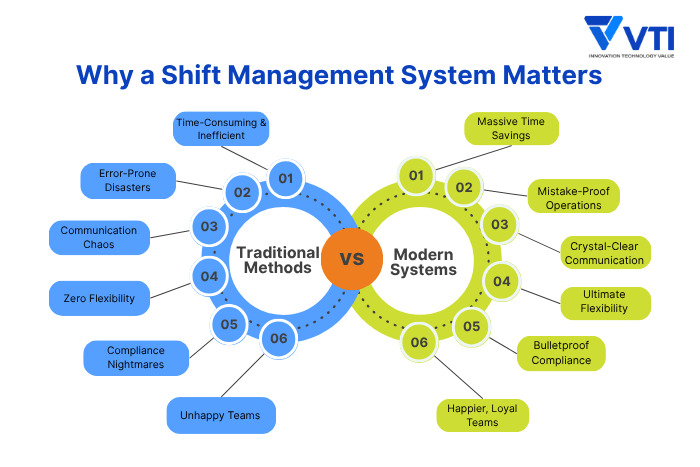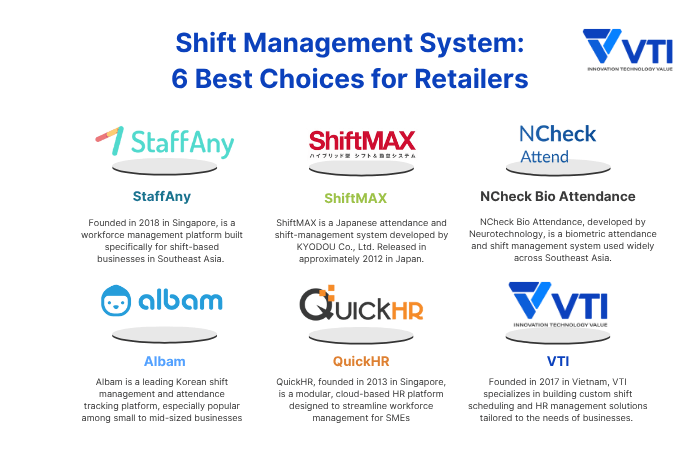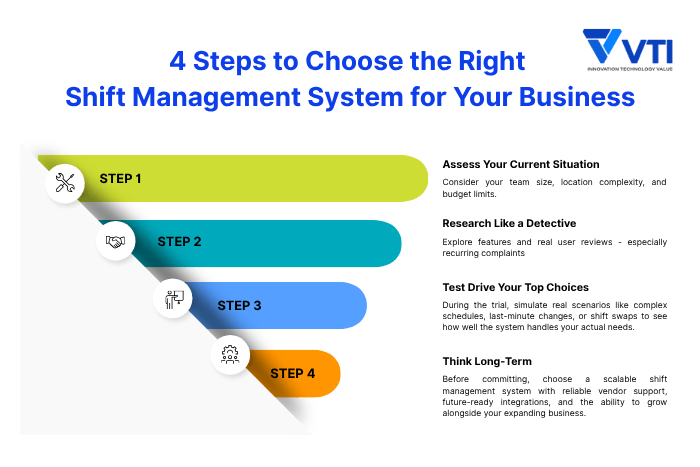Tired of spending hours on employee schedules only to deal with last-minute changes and coverage gaps? You’re not alone. Traditional scheduling methods – spreadsheets, phone calls, and handwritten rosters – can’t handle the complexity of modern retail and hospitality operations. A shift management system is your digital solution to scheduling chaos.
This guide covers everything you need to know: what these systems are, why they’re essential, key features to look for, and detailed comparisons of the top 6 solutions for Asia-Pacific businesses.
What is a Shift Management System?
A shift management system is a centralized digital platform that enables businesses to create, manage, and track employee work schedules efficiently – all from one place. Having a shift management system is like having a super-smart assistant that never sleeps.
But here’s the exciting part: today’s shift systems are much more than digital calendars. They’re actually three powerful tools rolled into one:
Communication Central: Imagine having a company bulletin board that everyone can access instantly. These systems serve as central hubs for sharing schedule updates, company announcements, and important news. No more playing phone tag or sending endless group texts.
Smart Workforce Optimizer: Like a crystal ball for your business, these platforms use data to forecast your staffing needs, reduce costly overstaffing and dangerous understaffing, and optimize your labor costs. They learn your business patterns and help you make smarter decisions.
Employee Happiness Booster: Modern workshift platforms offer self-service options, ensure fair scheduling practices, and provide real-time visibility into schedules. This transparency and empowerment lead to happier employees who stick around longer.
Why a Shift Management System Matters

Challenges of Traditional Shift Management Methods
Time-Consuming & Inefficient: Manual scheduling can eat up 5-8 hours of a manager’s week, time that could be spent improving customer service or growing the business.
Error-Prone Disasters: Paper schedules and spreadsheet systems are breeding grounds for mistakes. Double-bookings, missed shifts, and accidental understaffing happen way too often. These errors can cost a retail store thousands in lost sales during peak hours.
Communication Chaos: Relying on phone calls, text messages, and emails creates confusion. Important updates get lost, employees miss messages, and no-shows increase dramatically.
Zero Flexibility: When an employee calls in sick at the last minute, traditional systems offer no quick solutions. Managers scramble to find replacements, often working short-staffed or paying expensive overtime rates.
Compliance Nightmares: Manually tracking overtime rules, break requirements, and fair scheduling laws is like walking through a minefield. One mistake can result in costly fines or lawsuits.
Unhappy Teams: Inconsistent schedules, lack of transparency, and having no say in their workshift preferences lead to employee burnout and high turnover rates.
Benefits of Modern Shift Management Systems
Now, let’s flip the script. Here’s what happens when businesses embrace a proper shift management system:
Massive Time Savings: Automated scheduling features can reduce scheduling time by 75%.
Mistake-Proof Operations: Smart systems flag scheduling conflicts before they happen, automatically calculate overtime, and ensure adequate coverage. No more costly surprises.
Crystal-Clear Communication: Real-time updates and centralized messaging keep everyone informed. When schedules change, everyone knows instantly.
Ultimate Flexibility: Employees can request shift swaps, time off, and schedule changes through the app. Managers can approve or deny requests with one click, and the system updates everything automatically.
Bulletproof Compliance: Built-in alerts and automated reports ensure you never accidentally violate labor laws. The system becomes your compliance guardian angel.
Happier, Loyal Teams: When employees feel empowered and respected, they stay longer. Companies report up to 40% reduction in turnover after implementing modern shift systems.
Must-Have Features: What to Look for in a Shift Management System
When shopping for a shift management system, think of it like buying a car. You need certain features to get from point A to point B safely and efficiently. Here are the non-negotiables:
| Feature | Why It Matters |
| Automated & Template-Based Scheduling | Quickly build ideal schedules; reduce repetitive work |
| Centralized Communication Hub | Share announcements, send reminders, and prevent miscommunication |
| Employee Self-Service Portal | Boosts autonomy – employees can check, swap, and manage their shifts |
| Mobile App | On-the-go access for both managers and employees |
| Time & Attendance Tracking | Accurate wage calculation helps prevent buddy-punching (fraudulent clock-ins) |
| Reporting & Analytics | Clear metrics on labor costs, overtime, absenteeism, and trends |
| Integration Capabilities | Sync with payroll, HR, or POS systems for seamless operations |
| Compliance Tools | Custom rules; warnings for overtime or regulatory breaches |
Which is the Best Shift Management System?

1. StaffAny
StaffAny, founded in 2018 in Singapore, is a workforce management platform built specifically for shift-based businesses in Southeast Asia. It offers scheduling, time-tracking, and attendance tools tailored to industries like F&B, retail, and logistics. With a strong mobile-first approach, StaffAny is designed for both managers and frontline workers, ensuring clear communication, real-time updates, and labor law compliance across multiple locations.
The platform offers mobile-first features such as GPS and QR-based clock-ins, geofencing, real-time shift notifications, and alerts for late arrivals. It also integrates with payroll systems and POS platforms.
While StaffAny excels at scheduling and attendance tracking, it offers limited functionality outside these core areas and may not be suitable for enterprise-level HR workflows.
Pricing starts at SGD 5 – 8 per user per month, with custom pricing available for larger teams or enterprise deployments.
StaffAny mainly supports businesses in Singapore, Malaysia, and Indonesia, with growing adoption in other parts of Southeast Asia.
2. Albam
Albam is a leading Korean shift management and attendance tracking platform, especially popular among small to mid-sized businesses such as cafés, restaurants, convenience stores, and academies.
Launched by BlueNight Co., Ltd., Albam streamlines workforce operations through a user-friendly mobile-first design that supports GPS and Beacon-based check-ins, automated scheduling, and wage calculations. However, it is primarily tailored for small to mid-sized Korean businesses and may lack the scalability or depth required by larger enterprises.
Albam supports Android, iOS, and desktop platforms, with pricing tiers starting from a free plan for small teams, and affordable premium options ranging from ₩10,000 to ₩30,000 per month, depending on features and employee count.
Albam is primarily focused on the South Korean market, with limited adoption outside of Korea.
3. ShiftMAX
ShiftMAX is a Japanese attendance and shift-management system developed by KYODOU Co., Ltd. Released in approximately 2012 in Japan, ShiftMAX targets mid‑to‑large‑scale enterprises with diverse working-time rules and shift formats.
It specializes in advanced workforce planning and is especially popular in industries like healthcare, retail, and manufacturing. ShiftMAX offers detailed reporting tools, compliance with Japan’s strict labor laws, and support for high-volume operations.
However, its setup can be complex, and the pricing is geared toward enterprises. ShiftMAX pricing starts with a one-time setup fee of ¥58,300 – ¥118,800 for authentication terminals, while monthly usage fees are not publicly disclosed and require direct inquiry.
ShiftMAX is primarily used in Japan, with a strong alignment to Japanese labor regulations. Its use in other regions is limited due to localization and compliance complexity.
4. QuickHR
QuickHR, founded in 2013 in Singapore, is a modular, cloud-based HR platform designed to streamline workforce management for small and medium-sized enterprises (SMEs). Hosted on AWS and compliant with Singapore’s PDPA standards, QuickHR emphasizes security and reliability – making it well-suited for businesses across Southeast Asia. Its modular approach allows companies to scale features as needed, from core HR functions to full-suite capabilities.
While the platform offers strong local compliance and payroll integration, its user interface is less refined compared to global competitors. Additionally, its usage and support are primarily focused on Singapore and Malaysia.
Pricing starts at approximately $3 – $6 per user per month for core HR functions, with custom quotes available for the full suite.
QuickHR primarily serves businesses in Singapore and Malaysia, with some expansion into neighboring Southeast Asian countries.
5. NCheck Bio Attendance
NCheck Bio Attendance, developed by Neurotechnology, is a biometric attendance and shift management system used widely across Southeast Asia. It leverages facial recognition, fingerprint, and iris scanning technologies to track employee attendance accurately, making it particularly valuable for businesses where identity verification is crucial.
The system is hardware-flexible and works with existing devices like tablets, smartphones, or biometric scanners, eliminating the need for expensive custom installations. It is best for organizations needing secure and verified attendance tracking – such as factories, schools, hospitals, and warehouses.
NCheck is used across Southeast Asia, Eastern Europe, and parts of Africa, offering cross-border compatibility where biometric verification is required.
However, the interface can be less intuitive for non-technical users compared to more consumer-oriented attendance apps. Pricing is flexible and modular – licenses for personal, small business, and enterprise use
6. VTI
Founded in 2017 in Vietnam, VTI specializes in building custom shift scheduling and HR management solutions tailored to the needs of businesses. The platform supports features such as QR code or biometric attendance, payroll integration, and shift tracking – each configured based on individual client requirements.
The key strength lies in its flexibility. Businesses benefit from custom workflows, local implementation support, and seamless integration with existing payroll systems. This makes it a strong fit for organizations that need highly localized and adaptable HR tools.
Unlike many competitors with limited geographic reach, VTI offers multi-national support, especially in Asia countries. It has successfully implemented solutions for clients across Vietnam, Japan, Korea, Singapore, and other Southeast Asian markets — making it a strong choice for businesses with cross-border operations or regional expansion plans.
More than just solving a separate problem, VTI offers a comprehensive transformation for your business with its end-to-end retail development services. This ensures seamless integration of all departments.
Pricing is flexible and determined by the specific features and scale required. The solution is best suited for mid-to-large enterprises in the Asia-Pacific region seeking localized, regulation-compliant workforce management.
Quick Comparison at a Glance
Here’s a quick comparison of the six shift management systems:
| System | Best For | Strengths | Pricing |
| StaffAny | Shift-based businesses in Southeast Asia (F&B, retail, logistics) | Mobile-first design, GPS/QR clock-ins, real-time alerts, payroll/POS integration | SGD 5-8/user/month, custom pricing for large teams |
| Albam | Small to mid-sized Korean businesses (cafés, stores, academies) | Easy-to-use app, GPS/Beacon clock-ins, wage calculations | Free plan available, paid from ₩10,000-₩30,000/month |
| ShiftMAX | Large enterprises in healthcare, retail, and manufacturing | Advanced workforce planning, legal compliance support large teams | Setup: ¥58,300-¥118,800; monthly fees on request |
| QuickHR | SMEs in Singapore and Malaysia | Modular and scalable, secure (AWS + PDPA-compliant), good payroll integration | ~$3-6/user/month for core HR, custom for full suite |
| NCheck Bio Attendance | Organizations needing biometric verification (factories, schools, hospitals) | Facial, fingerprint, and iris recognition; hardware-flexible; high security | Modular pricing by license type (personal to enterprise) |
| VTI | Mid-to-large enterprises need customized HR/shift tools | Fully customizable, payroll compliance, labor law alignment, comprehensive service | Flexible/custom pricing based on project scope |
How to Choose the Right Shift Management System for Your Business

Choosing a shift management system is like choosing a business partner—you want someone reliable, compatible, and ready to grow with you. Here’s your step-by-step decision-making framework
Step 1: Assess Your Current Situation
Before choosing a shift management system, take a clear look at your business. Consider your team size, location complexity, and budget limits. A small boutique won’t need the same features as a multi-location chain. Know what you can afford monthly and focus on systems that solve your biggest issues – like no-shows, compliance, or poor communication.
Step 2: Research Like a Detective
Use comparison sites like Capterra (<- Cái này sau nên gắn những cái platform review mình đã đi backlink), G2, and Software Advice to explore features and real user reviews – especially recurring complaints. Don’t just skim the praise; critical reviews often highlight issues that might affect you. Also, tap into your network – peer recommendations can be more valuable than polished sales pitches.
Step 3: Test Drive Your Top Choices
Free trials are your friend. Most reputable shift management platforms offer 14–30-day trials – take advantage of them to test how the system works in real-world conditions. Involve your team in the process, especially supervisors and daily users, since their feedback is essential. During the trial, simulate real scenarios like complex schedules, last-minute changes, or shift swaps to see how well the system handles your actual needs.
Step 4: Think Long-Term
Before committing, check for scalability – your shift management system should grow with your business. If you’re planning to expand locations or staff, make sure the platform can keep up. Look into the vendor’s stability: are they financially sound and consistently improving their product? Strong customer support is also key – test their responsiveness during your trial. Lastly, think ahead about integrations. If you plan to add payroll, HR, or POS systems, choose a platform that can connect with them seamlessly.
Conclusion
Digital shift management is your ticket out of chaotic spreadsheets and last-minute scrambling – and your gateway to a happier, more productive team. The right workshift system saves valuable time and money, minimizes compliance risks, and supports your staff’s well-being.
Ready to explore shift management solutions tailored specifically for your business needs? Contact VTI for a custom consultation on how digital transformation can revolutionize your retail operations and create a comprehensive shift system that grows with your business.
![[FREE EBOOK] Strategic Vietnam IT Outsourcing: Optimizing Cost and Workforce Efficiency](https://vti.com.vn/wp-content/uploads/2023/08/cover-mockup_ebook-it-outsourcing-20230331111004-ynxdn-1.png)




